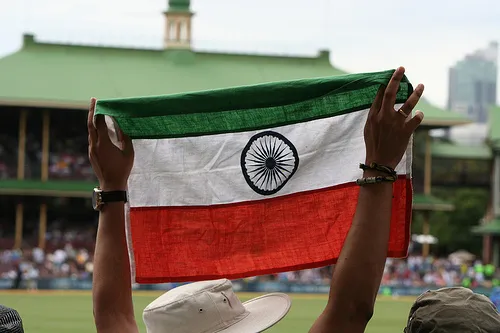
Here's why Indian economy could suffer from a double whammy
What could be plaguing it so bad?
According to Frederic Neumann, Co-Head of Asian Economic Research at HSBC, India potentially faces a double whammy. For weeks already, weather experts have pointed to the risk of a dry summer, which could raise the cost of food.
And now, to top it off, the trouble in Iraq has pushed up the price of oil. Well, it's all a bit theoretical at the moment: rain may still prove plentiful and the global oil markets unimpressed by the growing tensions in the Middle East.
Here's more from Frederic Neumann:
Still, India's economy is highly sensitive to developments on both fronts. A prolonged rise in the cost of crude would pose headaches for the government and RBI alike.
We've written quite a bit on the possibility of a drought and the pick-up in food inflation (see links at the end of this note). So let's focus on the latest risk: the gradual rise in the price of oil. Since the escalation of fighting in Iraq, Brent has broken through its recent trading range and topped USD 114 per barrel the last time we checked. This, to be sure, isn't exactly a "crisis level". In fact, it might be argued that for all that has transpired in the Middle East in recent weeks, crude is relatively well behaved.
And yet, given its importance for India, it is worth to keep a close eye on oil. First, there's the issue of inflation. This week's WPI reading was a powerful reminder that price pressures remain elevated. Energy costs were partly responsible for the upside surprise (6% y-o-y in May, up from 5.2% the previous month). According to estimates done by the RBI, a USD 10 per barrel increase in the price of crude, if sustained, can push up headline WPI by 1ppt directly, and by up to 2ppt if indirect effects are taken into account. Our estimates suggest a slightly weaker pass-through (0.6ppt directly and 0.8-1ppt indirectly over a 12 months period). Either way, pretty hefty stuff.
Second, higher oil prices could prove costly at a time when markets expect further belt-tightening. Energy is only partially liberalized, with the government picking up the tab for any discrepancy between international and domestic prices. Diesel is the big one, accounting for around 45% of losses incurred by oil companies. The initial plan was to narrow the deficit by raising prices incrementally every month. But, if the global price of crude starts to rise again sharply, the planned steps will be insufficient to close the gap and losses would start to widen again. All told, a USD 10 per barrel sustained increase in the price of oil, under the current policy setting, could add a fiscal burden of up to 0.4% of GDP. No small fry.
Third: the trade deficit. India has come a long way - quite impressively so - since last summer. The current account deficit, once a key worry for investors, has nearly vanished. Truth is, however, that this improvement is due to a mixture of cyclical and structural reasons. The latter comprises such things as the sharp correction of the exchange rate, with its benefits likely to persist for a while. The former is more short-lived and reflects, in part, the temporary slowdown in local demand that compressed imports. As the economy improves, these should pick up again. So some widening in the current account deficit seems already likely over the coming two quarters. Add to this rising oil prices and the process could accelerate. We estimate that a sustained USD 10 per barrel rise in the global cost of oil could add up to 0.5% of GDP to the current account deficit. Manageable, but not something to ignore.
Where does all this leave us? For now, pretty relaxed actually. By and large, global energy markets have taken recent turbulence in their stride (Ukraine first, now Iraq). Unless there is a considerable escalation in conflict in the Middle East, it may well be that oil prices quickly come off the boil. That would be good news for India. Conversely, if prices drift higher, well, then things will soon look more challenging. The stakes are high: for the RBI, for the government, for India.



![SBR 5 Lorem Ipsum News 2 [8 May]](https://cmg-qa.s3.ap-southeast-1.amazonaws.com/s3fs-public/styles/exclusive_featured_article/public/2025-05/a_hand_pointing_to_a_futuristic_technology_5b87c9d0e3_3.png.webp?itok=M3Hf-9XR)
![SBR 4 Lorem Ipsum [8 May Top Stories]](https://cmg-qa.s3.ap-southeast-1.amazonaws.com/s3fs-public/styles/exclusive_featured_article/public/2025-05/a_hand_pointing_to_a_futuristic_technology_5b87c9d0e3_2.png.webp?itok=2m5Wl0MX)


![Exclusive three SBR 12 Lorem Ipsum [8 May]](https://cmg-qa.s3.ap-southeast-1.amazonaws.com/s3fs-public/styles/exclusive_featured_article/public/2025-05/a_hand_pointing_to_a_futuristic_technology_5b87c9d0e3_11.png.webp?itok=8kn_UIfA)
![SBR 3 Lorem Ipsum [ Exclusive 2]](https://cmg-qa.s3.ap-southeast-1.amazonaws.com/s3fs-public/styles/exclusive_featured_article/public/2025-05/a_hand_pointing_to_a_futuristic_technology_5b87c9d0e3_1.png.webp?itok=YCyjLegJ)
![SBR 2 Lorem Ipsum [8 May]](https://cmg-qa.s3.ap-southeast-1.amazonaws.com/s3fs-public/styles/exclusive_featured_article/public/2025-05/a_hand_pointing_to_a_futuristic_technology_5b87c9d0e3_0.png.webp?itok=_cKD-29o)

![Video [Event News]](https://cmg-qa.s3.ap-southeast-1.amazonaws.com/s3fs-public/styles/event_news_featured_article/public/2025-05/screenshot-2025-05-08-at-4.58.53-pm_0.png.webp?itok=Kud35sMs)
![Event News SBR 9 Lorem Ipsum [8 may]](https://cmg-qa.s3.ap-southeast-1.amazonaws.com/s3fs-public/styles/event_news_thumbnail/public/2025-05/a_hand_pointing_to_a_futuristic_technology_5b87c9d0e3_8.png.webp?itok=DTh_dbYp)
![Event News SBR 9 Lorem Ipsum [8 May]](https://cmg-qa.s3.ap-southeast-1.amazonaws.com/s3fs-public/styles/event_news_thumbnail/public/2025-05/a_hand_pointing_to_a_futuristic_technology_5b87c9d0e3_7.png.webp?itok=vzDAzb6V)
![Event News SBR 8 Lorem Ipsum [8 May]](https://cmg-qa.s3.ap-southeast-1.amazonaws.com/s3fs-public/styles/event_news_thumbnail/public/2025-05/a_hand_pointing_to_a_futuristic_technology_5b87c9d0e3_6.png.webp?itok=jvHFc4P6)
![Video [Event News]](https://cmg-qa.s3.ap-southeast-1.amazonaws.com/s3fs-public/styles/video_thumbnail/public/2025-05/screenshot-2025-05-08-at-4.58.53-pm_0.png.webp?itok=yZnI0YBb)
![Video 1 SBR [8 May]](https://cmg-qa.s3.ap-southeast-1.amazonaws.com/s3fs-public/styles/video_thumbnail/public/2025-05/screenshot-2025-05-08-at-4.58.53-pm.png.webp?itok=9AAeRz_k)

 Advertise
Advertise

